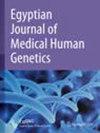原发性闭经患者的 MTHFR (C677T) 多态性及其与细胞遗传学和临床概况的关系
IF 1.1
Q4 GENETICS & HEREDITY
引用次数: 0
摘要
叶酸代谢异常是 DNA 低甲基化和染色体非连接的危险因素。MTHFR 是卵泡生成和卵巢发育的候选基因。本研究旨在调查原发性闭经患者中 MTHFR C677T 多态性的分布及其与细胞遗传学和临床特征的关系。我们采用聚合酶链式反应-限制性片段长度多态性方法,对 45 名原发性闭经女性和 45 名月经周期规律的对照女性(年龄匹配)进行了 MTHFR 多态性(C677T)检测。我们观察到,84.4%(n = 38)的对照组女性和 48.9%(n = 22)的病例组女性为 CC 基因型,13.3%(n = 6)的对照组女性和 24.4%(n = 11)的病例组女性为 CT 基因型(P = 0.039;χ2值4.253;奇异比0.316,95%CI 0.103-0.973),对照组女性中TT基因型占2.2%(n = 1),病例组女性中TT基因型占26.7%(n = 12)(p = 0.000266;χ2值13.294;奇异比0.048,95%CI 0.006-0.397)。在 45 名病例组女性中,26 名女性表现为 46,XX 核型,4 名女性表现为男性核型,3 名女性表现为纯合特纳核型,2 名女性为镶嵌特纳核型,其余女性表现为结构异常,如缺失、同源染色体和正常变异。血清值显示,与 CC 基因型相比,TT 基因型个体的孕酮水平明显较低(p = 0.032),放射学特征显示 MTHFR 基因在卵巢发育中起着重要作用(p = 0.024)。我们认为,MTHFR 多态性(C677T)可能是导致单体 X 女性染色体不连接的原因。它还会影响孕酮水平和卵巢发育,从而影响卵泡生成和卵巢储备,导致原发性闭经。本文章由计算机程序翻译,如有差异,请以英文原文为准。
MTHFR (C677T) polymorphism and its association with cytogenetic and clinical profile in individuals with primary amenorrhea
Abnormal folate metabolism is a risk factor for DNA hypomethylation and chromosomal nondisjunction. MTHFR is a candidate gene for folliculogenesis and ovarian development. In the present study, we aimed to investigate the distribution of the MTHFR C677T polymorphism in individuals with primary amenorrhea and it’s association with the cytogenetic and clinical profile. The MTHFR polymorphism (C677T) was checked in 45 females with PA and 45 control females (age-matched) with regular menstrual cycles using polymerase chain reaction-restriction fragment length polymorphism. We observed the CC genotype in 84.4% (n = 38) of the control group females and 48.9% (n = 22) of the case group females, CT genotype in 13.3% (n = 6) in the control group females and 24.4% (n = 11) in the case group females (p = 0.039; χ2 value 4.253; odd ratio 0.316, 95%CI 0.103–0.973) and TT genotype in 2.2% (n = 1) in the control group females and 26.7% (n = 12) in the case group females (p = 0.000266; χ2 value 13.294; odd ratio 0.048, 95%CI 0.006–0.397). Out of 45 case group females, 26 females showed 46,XX karyotype, 4 females showed male karyotype, 3 females showed pure Turner karyotype, 2 females were mosaic Turner and the rest of the females showed structural abnormalities like deletion, isochromosome and normal variants. The serum values revealed significantly lower levels (p = 0.032) of progesterone in the individuals with the TT genotype as compared to the CC genotype and the radiology profile showed a significant role of the MTHFR gene in ovarian development (p = 0.024). We suggest that the MTHFR polymorphism (C677T) might be responsible for the chromosomal nondisjunction in monosomy X females. It also influences the progesterone level and ovarian development, thus affecting folliculogenesis and the ovarian reserve responsible for primary amenorrhea.
求助全文
通过发布文献求助,成功后即可免费获取论文全文。
去求助
来源期刊

Egyptian Journal of Medical Human Genetics
Medicine-Genetics (clinical)
CiteScore
2.20
自引率
7.70%
发文量
150
审稿时长
18 weeks
 求助内容:
求助内容: 应助结果提醒方式:
应助结果提醒方式:


